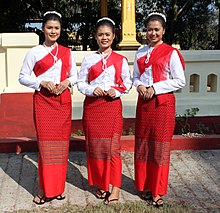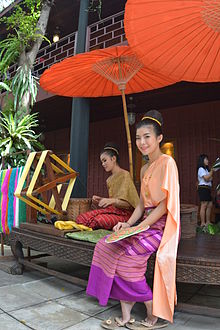Sbai
This article has multiple issues.Please helpimprove itor discuss these issues on thetalk page.(Learn how and when to remove these messages)
|

Sbai(Khmer:ស្បៃ[sɓaj];Lao:ສະໄບ[sā.bàj];Malay:Sebai;Jawi:سباي;Thai:สไบ,RTGS:sabai[sā.bāj]) orphaa biang(Lao:ຜ້າບ່ຽງ[pʰȁːbīaŋ];Thai:ผ้าเบี่ยง[pʰâːbìaŋ]) is a shawl-like garment worn by women inCambodia,Laos,andThailandto cover the breasts, while inSumatra,Borneoand theMalay Peninsula,the same term is used to describe a cloth hanging from the shoulders.[1]: 410 Thesbaiwas derived from the Indiansari,the end of which is worn over one shoulder.[1]: 153
Etymology
[edit]Sbaiis aKhmerword[2][3]that refers to any kind of thin and soft garment.[4]In clothing, it specifically refers to a shawl-like garment or breast cloth used mostly by women and to a lesser extent religious men.[5]
History
[edit]Sbai is derived from the Indiansari,which may have been introduced to Southeast Asia through theIndianized Kingdomsalong with other traditions and elements of Indian culture.[1]: 153
Cambodia
[edit]There are related mythologies inKhmer cultureconcerning the history ofsbai,which was likely introduced during theFunanera from India alongsidechang kbenin the first century AD. Thesbaiis mentioned in the legends ofPreah Thong and Neang Neak.In one scene, Preah Thong clings to a piece of cloth worn on the Nagini in order to make the journey to theNāga's kingdom; that piece of cloth is asbai.In that tale, thesbaiis symbolic of the tail of Neang Neak, the Nāga princess.[6][7]
In theAngkorian period,although it was common for men and women to be topless; however, clothes for the upper body were worn: the bas-reliefs ofBayon,Preah Khan,and other Angkorian temples depict women wearing a shawl-likesbaiwhile religious male figures are adorned with stylizedsbai.AtAngkor Wat,there are depictions of topless Apsaras holding sbai connected to theirsampot,while the northern wall of Angkor Wat depicts a group of ladies wearing longsbaiholding various offerings.
Bas-reliefs of Khmer women wearing sbai during the Angkor period (802 AD-1431 AD)
Nowadays,sbai,along withchang kbenandsampot,are regarded as Cambodia's national costumes.[8]Sbai most often used in traditional Khmer weddings with different type and decoration during the rite ofPreah Thong Taong Sbai Neang Neak(transl. Preah Thong holding on to the sbai of Neang Neak) which represents the legend of the foundation of Funan and where the groom holds on to the bride'ssbaias they go to their room. The groom also wears asbai.[9]
For men, especially Brahmin and Buddhist monk, thesbaicalledsbong sbai trai chivor,[5]and is considered the robe of Hindu and Buddhist monks.[10]For women,sbaican be freely used and in different ways such as to wrapping it around the body, covering the shoulder, and commonly covering the breast and stomach over the left shoulder. Different styles ofsbaiare used by Cambodian women based on their preferences and traditions.
Laos
[edit]
In Laos, this garment is known asphaa biangor sabai. It is common for Lao women to wearsabaias it is considered traditional clothing. Asabaican also be worn by men in weddings or when attending religious ceremonies. The type ofsabaitypically worn by Lao men often has checkered patterns.Sabaican also be a long piece of silk, about a foot wide, that is draped diagonally over the chest covering one shoulder with one end dropping behind the back.[11]
Malaysia
[edit]In Malaysia, Sebai is a cloth wrapped around the neck to cover the shoulders with both ends hanging on the chest similar to a scarf hung over the shoulders.[12]
Myanmar
[edit]
Theethnic Monis also known to have similar tradition of wearing the shawl-likesabaicalledyat tootinMonlanguage, diagonally over the chest covering one shoulder with one end dropping behind the back like that worn by Lao women. This tradition distinguished them from other ethnic groups in Myanmar. The Mon people of Myanmar and Thailand today were the descendants of various Indianized polities, notablyDvaravati.Artifacts from Dvaravati sites in what is now Thailand depicted a group of ladies wearing what is similar tosabai.
Thailand
[edit]
Artifacts found inethnic MonDvaravatisites depict group of ladies wearing what is similar tosabai. Sabai(Thai:สไบ,RTGS:sabai,pronounced[sābāj]) or pha biang (Thai:ผ้าเบี่ยงpronounced[pʰâː.bìaŋ]) is shawl-like garment, or breast cloth. Sabais can be used by women or men. The sabai is also known as a long piece of silk, about a foot wide, draped diagonally around the chest by covering one shoulder which its end drops behind the back. Sabais could be worn around the naked chest or on top of another cloth. The practice of wearing Sabai along with Victorian cloth was a common practice during the reign of King Chulalongkorn and lasted until the reign of King Vajiravudh when Westernized clothing became more fashionable.
Gallery
[edit]-
Figures wearing stylisedsbaidepicted onAngkoriantemples
-
QueenAng Meyand her daughters wearingsbaiin the 1800s
-
Lady Pun Bunnag,Somdet Chaophraya Borom Maha Sri Suriwongse's wife wearingpha biang,1866
-
Siamese girl wearingpha biang,1921
-
Daughters ofKing Rama IIandKing Rama IIIwearingpha biangin the 1800s
-
Queen Debsirindra,the second consort of KingMongkutwearingpha biang,1855
-
Cambodian bride wearing asbaiin a wedding ceremony
-
Dancer wearingsbai
See also
[edit]- Sampot Chang Kben
- Khmer Traditional Dress
- Culture of Cambodia
- Chut thai
- Sampot
- Sampot Samloy
- Kemben
- Malaysian cultural outfits
- Sari
- Traditional Thai clothing
References
[edit]- ^abcMaxwell, Robyn J.; Gittinger, Mattiebelle (2003).Textiles of Southeast Asia: Tradition, Trade and Transformation.Periplus Editions.ISBN9780794601041.
- ^Varasarin, Uraisi (1984).Les éléments khmers dans la formation de la langue siamoise(in French). Peeters Publishers. p. 113.ISBN978-2-85297-161-5.
- ^"สไบ - Thai / English dictionary meaning - สไบ ภาษาอังกฤษ แปล ความหมาย".thai2english.Retrieved2020-03-09.
- ^Chuon Nath Khmer Dictionary. 1966, Buddhist Institute, Phnom Penh
- ^ab"លក្ខណៈពិសេសនៃពណ៌ស្បង់ចីវររបស់ព្រះសង្ឃពុទ្ធសាសនា".Radio Free Asia(in Khmer). 2015-01-21.Retrieved2019-09-07.
- ^"Custom & Tradition".cambodiancommunityday.org.Retrieved2020-03-09.
- ^Nadeem, Zuha (2019-10-01)."Traditional Thai Clothing-16 Beautiful Outfits From Thailand".Outfit Trends - Ideas How to Wear & What to Wear.Retrieved2020-03-09.
- ^Books, Better World."Buy New & Used Books Online with Free Shipping".Better World Books.Retrieved2020-02-24.
- ^Nadeem, Zuha (2019-10-01)."Traditional Thai Clothing-16 Beautiful Outfits From Thailand".Outfit Trends - Ideas How to Wear & What to Wear.Retrieved2020-03-06.
- ^"Civara, aka: Cīvara; 10 Definition(s)".Wisdom Library.2009-04-11.Retrieved2019-09-07.
- ^Bonnie Ghazarbekian, Jane Siegel,Sawaddi, 15 years,p.130.
- ^"Carian Umum - Sebai".prpm.dbp.gov.my(in Malay).Retrieved2020-11-15.
External links
[edit]![]() Media related toSbaiat Wikimedia Commons
Media related toSbaiat Wikimedia Commons














